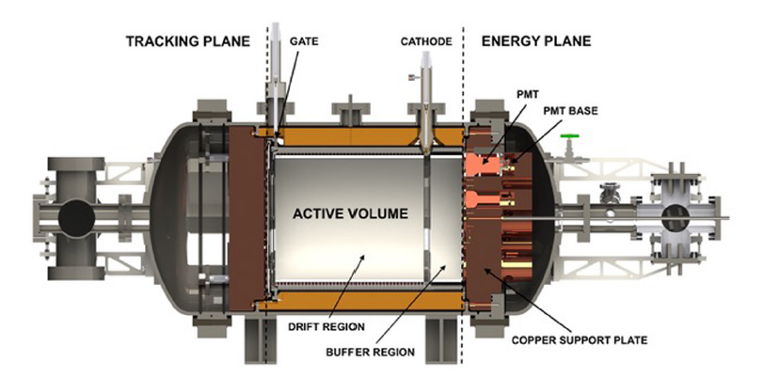First neutrinoless double beta decay search with a NEXT detector
Deep below the Spanish side of the Pyrenees, we find the LSC (Laboratorio Subterráneo de Canfranc – Canfranc Underground Laboratory), where the NEXT experiment is taking place. Its goal is one of the remaining holy grails of particle physics: the proof that the neutrino is its own antiparticle, a result with profound meaning not only in the nature of the neutrino itself, but also in the creation of our universe.
Neutrinos are the only particles in the Standard Model that could be Majorana fermions, that is, completely neutral fermions that are their own antiparticles. Majorana neutrinos imply the existence of new physics at an energy scale inversely proportional to the observed neutrino masses; given that the neutrino mass is so tiny, the energy scale involved is extremely huge. This new-physics scale provides a simple explanation for the striking lightness of neutrinos, and is possibly connected with the predominance of matter over antimatter in the universe.
Radioactive isotope 136Xe can undergo a special kind of decay known as double beta decay (2νββ). In that event, two electrons and two neutrinos are emitted from the xenon atom. If the neutrino is its own antiparticle, two neutrinos in the same region of space have a chance of annihilate themselves, and only electrons could be observed. The actual mechanism is rather complex, but at the end of the day, if the neutrino is a Majorana particle, a double beta decay could only emit two electrons and not the whole pack of electrons and neutrinos. NEXT aims to detect precisely that: a neutrinoless double beta decay (0νββ).
The NEXT-White detector implements the first radiopure demonstrator of the NEXT technology. Although NEXT-White was conceived as a prototype of the NEXT-100 detector and a future ton-scale device, its outstanding performance has allowed the measurement of the half-life of the double beta decay in 136Xe.

Now, the Next Collaboration explores the first 0νββ search with a NEXT detector 1. Adopting the same data samples and analysis strategies used for the measurement of the half-life of the decay, this analysis incorporates for the first time the contribution of the cosmogenic backgrounds in NEXT, which are particularly relevant in the region of interest for the 0νββ signal.
While a competitive result cannot be achieved due to the limited fiducial xenon mass (3.5 kg), the excellent performance of NEXT-White provides a proof-of-concept for 0νββ searches in future NEXT detectors. The analysis considered 271.6 days of 136Xe-enriched data and 208.9 days of 136Xe-depleted data. As a preliminary step, a detailed background measurement in both data samples was conducted to ensure the time stability of the different contributions.
The radiogenic-induced backgrounds were modelled upon the screening of the detector materials. Up to 12 radiogenic contributions were accounted for. The model for cosmogenic-induced backgrounds was derived from Monte Carlo simulations and the NEXT-White data collected above 2.7 MeV, the maximum energy of the radiogenic background.
Activations of 63Cu and 65Cu (in the natural copper used as an internal shielding) are found to be the dominant cosmogenic contributions, while the activation of 136Xe is negligible. All the background contributions are measured independently in both sets of data, yielding consistent results between the two periods. No 0νββ signal is observed in the NEXT-White data. From the background-model-dependent and the background-subtraction fits, 90% C.L. limits for the half-life of greater than 5.5 × 1023 yr and 1.3 × 1024 yr, respectively, are derived. The background-subtraction result was found to be more sensitive.
These results demonstrate the unique capabilities of the NEXT technology. A similar approach may be used in NEXT-100 and future detectors to conduct low-background, and virtually background-model-independent, searches for neutrinoless double beta decay.
Author: César Tomé López is a science writer and the editor of Mapping Ignorance
Disclaimer: Parts of this article may have been copied verbatim or almost verbatim from the referenced research paper/s.
References
- The NEXT Collaboration (2023) Demonstration of neutrinoless double beta decay searches in gaseous xenon with NEXT Journal of High Energy Physics doi: 10.1007/JHEP09(2023)190 ↩